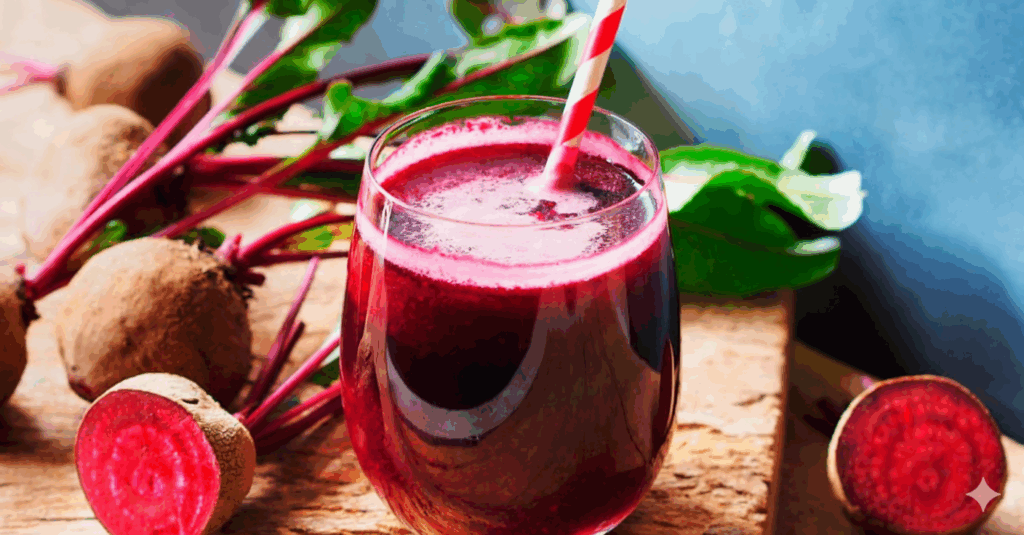
The Performance Edge: A Deep Dive into Beetroot Juice, Nitric Oxide, and Evidence-Based Dosing
I. Introduction: The Power of the Underground Superfood
Beetroot juice (BRJ) has transitioned from a traditional food item to a scientifically validated, natural ergogenic aid, earning its place alongside established performance supplements. The focus of research is not merely on its caloric or vitamin content, but on its unique capacity to fundamentally improve physiological efficiency during exercise.
The profound performance benefits derived from BRJ are primarily attributed to its high concentration of inorganic dietary nitrate (NO3−). Once ingested, this compound serves as the precursor to nitric oxide (NO), a powerful signaling molecule within the cardiovascular and muscular systems. By augmenting the body’s endogenous NO production, BRJ consumption can stimulate vasodilatation, modulate muscle contraction mechanics, and enhance the function of the cellular powerhouses, the mitochondria. These mechanistic changes result in measurable performance enhancements, including delayed fatigue and increased power output, making BRJ a crucial consideration for serious athletes and fitness enthusiasts seeking a competitive edge. This expert analysis synthesizes the scientific literature to provide precise, evidence-based guidelines for optimizing BRJ intake, detailing both the acute and chronic protocols necessary for maximizing endurance and strength outcomes, while also addressing critical population-specific effects and practical caveats.
II. Deconstructing the Mechanism: The Nitrate-Nitrite-Nitric Oxide Pathway
The ergogenic effects of BRJ stem from a complex, non-traditional metabolic pathway that converts an inert inorganic salt into a key signaling molecule. Understanding this conversion is essential for optimizing supplementation protocols.
A. Chemical Composition: High-Value Bioactives
The effectiveness of beetroot as a supplement hinges on two principal classes of bioactive components.
The Role of Dietary Nitrate (NO3−)
Beetroot is exceptionally rich in dietary nitrate. While nitrate is found in many green leafy vegetables, beetroot concentrate provides a highly potent and convenient source for athletes requiring specific dosing. Analysis of raw beetroot, for instance, confirms its nutrient profile, including 9.56 g/100g total carbohydrates and 2.8 g/100g total dietary fiber. The primary focus, however, remains the inorganic nitrate content, as it is the direct precursor to the performance-enhancing molecule, nitric oxide.
The Contribution of Betalains
Beyond nitrate, beetroot juice contains betalain pigments, most notably betanin, which impart the characteristic dark red-violet color. These water-soluble compounds are vital components of the beetroot matrix, providing significant health benefits that extend beyond mere vasodilation. Research has confirmed that betalains act as potent antioxidants and exhibit robust anti-inflammatory properties. Their main target mechanism involves modulating the transcription factor NFkB, thereby minimizing the production of pro-inflammatory cytokines, reactive oxygen species (ROS), and reactive nitrogen species (RNS).
The presence of betalains introduces a complementary protective mechanism. If performance improvement relied strictly on NO availability, an isolated sodium nitrate salt would be equally effective. However, the consistent recommendation by researchers to utilize natural vegetable products rather than commercial nitrate salts suggests that the broader nutritional matrix is important. The betalain-mediated reduction in exercise-induced oxidative stress and inflammation likely complements the NO-driven efficiency gains, potentially accelerating recovery and adaptation over chronic use.
B. The Critical Pathway: From Ingestion to Vasodilation
The conversion of dietary nitrate into bioactive nitric oxide follows a unique three-step process known as the nitrate–nitrite–NO pathway, complementing the traditional L-arginine–nitric oxide synthase (NOS) pathway.
Absorption and Reduction
Upon ingestion, nitrate is rapidly absorbed in the proximal intestine. Approximately 25% of this circulating nitrate is actively taken up and concentrated in the salivary glands, where it is secreted into the oral cavity.
The crucial conversion step relies entirely on the oral microbiome. Commensal facultative anaerobic bacteria residing on the dorsal surface of the tongue reduce the nitrate (NO3−) to nitrite (NO2−). This highlights the essential role of the oral bacteria—a rate-limiting step in the process. This nitrite is then swallowed. While some is converted to NO in the acidic environment of the stomach, a substantial amount enters the systemic circulation, leading to a measurable increase in plasma nitrite concentration.
Activation and Physiological Effect
The systemic nitrite circulates throughout the body, awaiting conversion to nitric oxide. This final reduction is catalyzed by various enzymes and proteins, including deoxyhemoglobin. Critically, this final step is heavily facilitated under specific physiological conditions: low oxygen availability (hypoxia) and low pH. These conditions are precisely those found in working skeletal muscle during intense exercise, meaning the body is engineered to produce NO exactly where it is needed most.
Nitric oxide is a powerful vasoactive agent. Its increase leads to vasodilatation, which improves blood flow, enhances oxygen and nutrient delivery to active tissues, and demonstrably decreases both systolic and diastolic blood pressure (BP) in both healthy individuals and hypertensive patients. One study demonstrated that ingesting 500 mL of beet juice caused an acute reduction in systolic and diastolic BP in healthy subjects.
C. NO’s Role in Exercise: Enhancing Muscle Efficiency
The most significant ergogenic effect of increased NO bioavailability is the improvement in muscle efficiency—a reduction in the energy (adenosine triphosphate, ATP) cost required to produce a given amount of force.
Reduction in Oxygen Cost (VO˙2)
Nitrate supplementation reliably reduces the whole-body oxygen cost of submaximal exercise (VO˙2). This means the athlete expends less oxygen (and therefore less fuel) to maintain a specific pace or power output. This physiological shift is directly responsible for enhanced exercise tolerance and performance.
Mechanism 1: Optimized Mitochondrial Efficiency
The reduced oxygen cost is largely a consequence of altered muscle energy metabolism, specifically an improvement in the efficiency of oxidative phosphorylation within the mitochondria. NO is believed to modulate mitochondrial respiration by reducing the expression of adenine nucleotide translocase (ANT), a protein linked to proton leak respiration. The physiological consequence of this modulation is a profound improvement in efficiency. Evidence suggests that supplementation can increase the mitochondrial P/O ratio (the ratio of ATP produced per oxygen molecule consumed) by as much as 19%.
An increase in the ATP yield per oxygen consumed—a 19% enhancement in mitochondrial efficiency—represents significant ATP sparing. This mechanism allows the muscle to continue functioning effectively with fewer metabolic stimuli, such as adenosine diphosphate (ADP) and inorganic phosphate (Pi), required to drive respiration. This blunting of metabolic changes is central to the delay of fatigue.
Mechanism 2: Attenuating the VO˙2 Slow Component
During high-intensity, heavy-domain exercise, muscle efficiency progressively declines, reflected by a rise in the VO˙2 ‘slow component.’ This slow component typically indicates the increasing inefficiency and accumulating fatigue as exercise continues. Nitrate supplementation has been shown to cause a significant 23% reduction in the amplitude of this VO˙2 slow component. Maintaining efficiency later in a high-intensity effort is a direct determinant of endurance capacity, allowing for a longer sustained effort before exhaustion.
III. Performance Benefits: Translating Science into Athletic Gains
The physiological effects of BRJ translate into tangible, measurable performance improvements across various athletic disciplines, particularly those characterized by high energy expenditure and high-intensity demands.
A. Aerobic Endurance and Efficiency Gains
The initial and most robustly documented benefit of BRJ is the enhancement of sustained aerobic performance. This is evidenced by improvements in time-to-exhaustion (TTE) and competitive time trials.
Dietary nitrate supplementation significantly enhances exercise tolerance. For example, chronic daily dosing (one week) with a relatively low dose of 6.1 mmol inorganic nitrate improved submaximal aerobic endurance—measured as cycling time to exhaustion at 75% of maximal power output—by 24% in a patient population. This demonstrates the potent systemic effect of maintained nitrite levels.
In competitive settings, trained cyclists achieved meaningful performance gains. Acute BRJ supplementation improved time trial completion by 2.7% in a 16.1 km test and by 2.8% in a 4 km test. Even trained runners participating in a 5000-m test, a population often thought to be less responsive, showed enhanced performance in the critical closing stages, running 5% faster in the last 1.1 miles of the race.
B. High-Intensity Power, Strength, and Repeated Efforts
While the efficiency gains are key for endurance, the benefits for high-intensity, anaerobic efforts are rooted in optimizing muscle mechanics and recovery kinetics.
Enhanced PCr Resynthesis
For sports requiring explosive, intermittent power (such as team sports, rowing, or weightlifting), the primary mechanism involves optimizing the phosphocreatine (PCr) system, the rapid fuel source for short, maximal sprints. BRJ supplementation has been strongly linked to faster PCr resynthesis. Because accelerating the replenishment of this high-energy phosphate delays its depletion during repeated anaerobic efforts, it functionally enhances the muscle’s ability to repeat sprints or maximal lifts.
These mechanistic shifts translate into improved measured power output. In a test involving 24 repetitions of 6-second sprints interspersed with short rest periods, BRJ consumption resulted in a statistically significant +5% improvement in mean average power output. Furthermore, the intervention may involve a mechanism that improves muscle power output via a faster muscle shortening velocity.
Muscular Strength and Endurance
Systematic reviews confirm that BRJ supplementation enhances muscular endurance generally, specifically manifesting as an increase in repetitions or prolonged time to fatigue. For professional athletes, studies have shown that appropriate supplementation specifically
improves muscular strength , indicating a benefit that extends beyond simple cardiovascular optimization.
C. Enhanced Fatigue and Lactate Tolerance
The overall systemic improvements contribute directly to managing the metabolic byproducts of intense exercise. Appropriate supplementation has been found to improve overall lactate tolerance in both athletes and non-athletes. This suggests an improved capacity to manage or buffer the metabolic acidosis associated with sustained, high-intensity work. The faster kinetics of high-energy phosphate resynthesis and the blunted changes in energy metabolites (
ADP, Pi) are the direct chemical evidence underlying the observed reduction in muscular fatigue during high-intensity exercise.
IV. The Strategy: Optimal Dosage and Timing Protocols
For the conversion of dietary nitrate into performance benefits to be maximized, the timing and concentration of the dose must adhere to protocols validated by clinical research.
A. Defining the Nitrate Dosage Target: The mmol Sweet Spot
The quantification of effective BRJ dosage is standardized based on the inorganic nitrate content, measured in millimoles (mmol), which reflects the amount of bioactive precursor available.
Systematic reviews of dietary nitrate supplementation recommend a high dose range of 8.3–16.4 mmol of nitrate per day or per acute administration. This range is equivalent to approximately 515–1017 mg of nitrate. This target range represents the optimal load required to significantly increase plasma nitrite concentration and elicit measurable ergogenic effects.
It is noted that even intermediate doses (such as 6 mmol) have demonstrated efficacy in reducing the oxygen uptake (VO˙2) during high-intensity exercise. However, consistent high-end dosing is generally required to ensure maximum physiological saturation and effect, particularly in experienced athletes. Importantly, the benefits are consistently linked to natural vegetable products (BRJ or concentrate), reinforcing the mandate to avoid commercial sodium nitrate or nitrite salts.
B. Supplementation Protocols
Research protocols have established two distinct, effective strategies for BRJ consumption, depending on the performance objective: acute loading for immediate competitive impact and chronic loading for sustained physiological adaptation.
Acute Loading Protocol
For a single race day, time trial, or crucial workout, an acute dose is highly effective.
The optimal timing window requires the consumption of the high dose (8.3–16.4 mmol) 2 to 3 hours pre-exercise. This protocol ensures that the plasma nitrite concentration peaks precisely when the metabolic demand of the exercise begins, enabling the rapid conversion of nitrite to NO within the hypoxic muscle environment. This method is effective for shorter time trials and maximum efforts, with studies noting that ergogenic effects are typically observed at 150 to 180 minutes after ingestion.
Chronic Loading Protocol
Chronic, sustained supplementation is recommended for longer training blocks, multi-day events, or generalized improvements in systemic efficiency.
To maintain elevated circulating nitrite levels, daily intake is required for a minimum of ≥3 days, with consistency over one week showing the most robust and systemic benefits. A study focusing on submaximal aerobic endurance found that one week of daily dosing (6.1 mmol) was effective in improving exercise capacity and reducing resting blood pressure. Chronic dosing is particularly advantageous for maximizing training efficiency over a period of high volume and ensuring sustained BP reduction.
The following table summarizes the research-backed strategies for maximizing performance benefits through BRJ supplementation:
Table 1: Optimal Beetroot Juice Supplementation Protocols
| Strategy | Dosage (Nitrate mmol/day) | Timing | Primary Benefit |
| Acute Loading | 8.3 – 16.4 mmol | 2–3 hours prior to competition/exercise | Maximized efficiency (VO˙2 cost reduction), increased Time to Exhaustion (TTE) in limited efforts |
| Chronic Loading | 6.1 – 16.4 mmol | Daily intake for ≥3 days (optimally 7 days) | Systemic blood pressure control, sustained submaximal endurance improvement, training efficiency gains |
V. The Nuance of Training Status: Athlete vs. Enthusiast
The magnitude and type of performance improvement derived from BRJ are critically dependent upon the individual’s baseline training status and fitness level. This variability is a key finding in performance physiology, demonstrating that the ergogenic effects are population-specific.
A. Maximizing Gains in the Non-Elite Population
In healthy, recreationally active individuals, or those with lower baseline VO˙2max, the physiological system possesses a large capacity for improvement via increased vasodilation and oxygen delivery.
For this population, the primary and most reliable performance boost is seen in aerobic endurance and exercise economy. The improved mitochondrial efficiency (higher P/O ratio) effectively lowers the energetic burden of sustained effort. This population often experiences significant gains in
VO˙2max and substantial improvements in Time To Exhaustion during moderate-to-high intensity efforts.
B. Navigating the Ceiling Effect in Highly Trained Athletes
Highly trained endurance athletes, characterized by high baseline VO˙2max values (e.g., 60−70 mL⋅kg−1⋅min−1), possess already optimized cardiovascular systems and muscular oxidative capacities. Consequently, these individuals often exhibit a “ceiling effect”. Their capacity for systemic improvements via vasodilation and enhanced oxygen delivery is limited, meaning BRJ may not significantly improve primary aerobic metrics like
VO˙2max or sustained aerobic performance. Several studies involving highly trained endurance athletes have reported no ergogenic effect on performance.
When the systemic benefits plateau, the ergogenic advantage shifts away from aerobic efficiency toward specific, high-intensity metrics. For elite athletes, the observed benefits include enhanced muscular strength, power output, and the ability to sustain repeated sprints. The mechanism becomes focused on optimizing rapid muscle kinetics, such as faster
PCr resynthesis and enhanced muscle shortening velocity.
However, the response is not entirely universal. Some research suggests that even highly trained populations can see benefits; one study found that female endurance athletes demonstrated a significant 4.82% increase in maximal oxygen consumption (VO˙2max) after acute supplementation. This suggests that the effect remains highly nuanced and may be influenced by factors such as sex, muscle groups involved, training methodology, and individual metabolic profiles.
The mixed findings dictate that athletes with elite aerobic capacity must utilize BRJ primarily to mitigate fatigue and enhance power during high-intensity intervals or repeated sprint drills , rather than relying on it for large, sustained increases in aerobic capacity.
Table 2 provides a comprehensive overview of the differential effects of BRJ based on the consumer’s training level:
Table 2: Performance Effects Based on Training Status
| Population Group | Primary Performance Improvement Focus | Proposed Mechanism of Action | Associated Outcomes |
| Non-Athletes/Healthy Adults | Aerobic Endurance & Efficiency | Improved mitochondrial P/O ratio, reduced VO˙2 cost, systemic vasodilation | Significant gains in VO˙2max, increased Time To Exhaustion (TTE) in moderate intensity |
| Professional/Highly Trained Athletes | Muscular Strength, Power, Fatigue Attenuation | Faster Phosphocreatine (PCr) resynthesis kinetics, enhanced muscle shortening velocity | Improved repeated sprint performance (e.g., +5% mean power), enhanced strength recovery |
VI. Essential Caveats: Side Effects and Supplementation Sabotage
While BRJ is generally regarded as safe, its efficacy is dependent on specific biological conditions, and certain potential side effects must be managed.
A. The Mouthwash Warning: Protecting Your Nitrite Factory
The most critical practical caveat involves protecting the delicate metabolic pathway that converts nitrate to nitric oxide. This process is fundamentally reliant on the oral microbiome.
The use of antiseptic mouthwash acts as a direct form of supplementation sabotage. By sterilizing the oral cavity, antiseptic mouthwashes indiscriminately kill the commensal facultative anaerobic bacteria essential for the nitrate-to-nitrite reduction. The observed effect of this disruption is profound: studies show that twice-daily use of an antiseptic mouthwash attenuated salivary nitrite concentration by approximately 90% and plasma nitrite concentration by 25%.
This severe loss of NO bioavailability immediately impairs cardiovascular function. The systemic consequence of this is a significant rise in systolic and diastolic blood pressure, increasing by 2 to 3.5 mmHg within 24 hours of starting the mouthwash intervention. This documented rise in blood pressure confirms the functional destruction of the vasodilatory pathway. Therefore, to ensure that the dietary nitrate pathway remains functional and the ergogenic benefits are retained, any athlete utilizing BRJ must strictly abstain from using antiseptic mouthwash, particularly in the hours leading up to and after dosing.
B. Managing Side Effects and Contraindications
Consumption of BRJ is generally safe, with few adverse events reported. However, specific side effects are associated with high intake.
Beeturia
The most visually startling, yet medically harmless, side effect is beeturia, which results in the discoloration of urine and/or stools to a red or pink hue. This phenomenon is caused by the incomplete metabolism and subsequent excretion of the betalain pigments (betanin) found in the juice. The extent of discoloration can vary based on the dosage and whether the individual has low stomach acid, which can hinder the absorption and metabolism of the pigments.
Gastrointestinal Distress
Beetroot contains a notable amount of dietary fiber, contributing 2.8 g per 100 g of the raw product. For individuals with sensitive stomachs or those who are unaccustomed to a high-fiber diet, consuming large amounts of BRJ, particularly concentrates, can lead to mild digestive distress such as gas, bloating, or cramps.
Hypotension Risk
Given that a primary physiological effect of BRJ is the acute reduction of resting systolic and diastolic blood pressure , individuals who already have low blood pressure or those taking antihypertensive medications should exercise caution. While rare, monitoring for symptoms such as light-headedness or headache is advisable. One participant in a trial reported a headache lasting approximately 10 minutes after consuming the nitrate-containing BRJ.
Oxalate Content
Beetroots are naturally rich in oxalates. While oxalates are a common dietary component, when consumed in very large quantities, they can bind with calcium and increase the risk of forming calcium oxalate kidney stones in susceptible individuals.
VII. Conclusion: Evidence-Based Fueling
The scientific evidence unequivocally establishes beetroot juice as a potent and effective ergogenic aid for enhancing athletic performance, rooted in its unique metabolic conversion of dietary nitrate into nitric oxide. The core mechanism—centered on improving mitochondrial efficiency, lowering the VO˙2 cost of submaximal exercise, and enhancing high-energy phosphate kinetics—provides profound physiological advantages that delay the onset of fatigue across various exercise domains.
Optimization of these benefits necessitates strict adherence to research-validated protocols. The recommended dosage for significant performance enhancement is a high nitrate load of 8.3–16.4 mmol. This dose should be applied either acutely (2–3 hours pre-exercise) for immediate results in competition or chronically (daily for
≥3 days) for sustained improvements in training efficiency and systemic physiology.
Furthermore, the analysis reveals that performance gains must be strategically targeted: non-athletes and healthy individuals should anticipate the greatest benefit in improved aerobic endurance, while highly trained elite athletes, often facing a ceiling effect in aerobic capacity, should leverage BRJ primarily for its ability to enhance muscular strength, power output, and mitigate fatigue during repeated, high-intensity efforts.
Finally, the most critical practical consideration for any athlete using BRJ is the avoidance of antiseptic mouthwash. The reliance of the nitrate-nitrite-NO pathway on the commensal oral bacteria means that disrupting this microbiome neutralizes the ergogenic effect, leading to the functional loss of increased NO bioavailability. By understanding and adhering to these nuanced, data-driven strategies, athletes can harness the full performance potential of beetroot juice.
Consult with the Doctors at Corner on Wellness Chiropractic Center to help you achieve your athletic goals. The Doctors have certifications in Sports Chiropractic and Extremity adjusting.
CONTACT
Better health and wellness is just a click or call away
UPCOMING EVENTS
WIN a Laser Treatment for sharing, referring, or giving a Google Review!
October 1 - October 31OPEN
October 11Indigenous Peoples’ Day
October 13Happy Canadian Thanksgiving!
October 13





